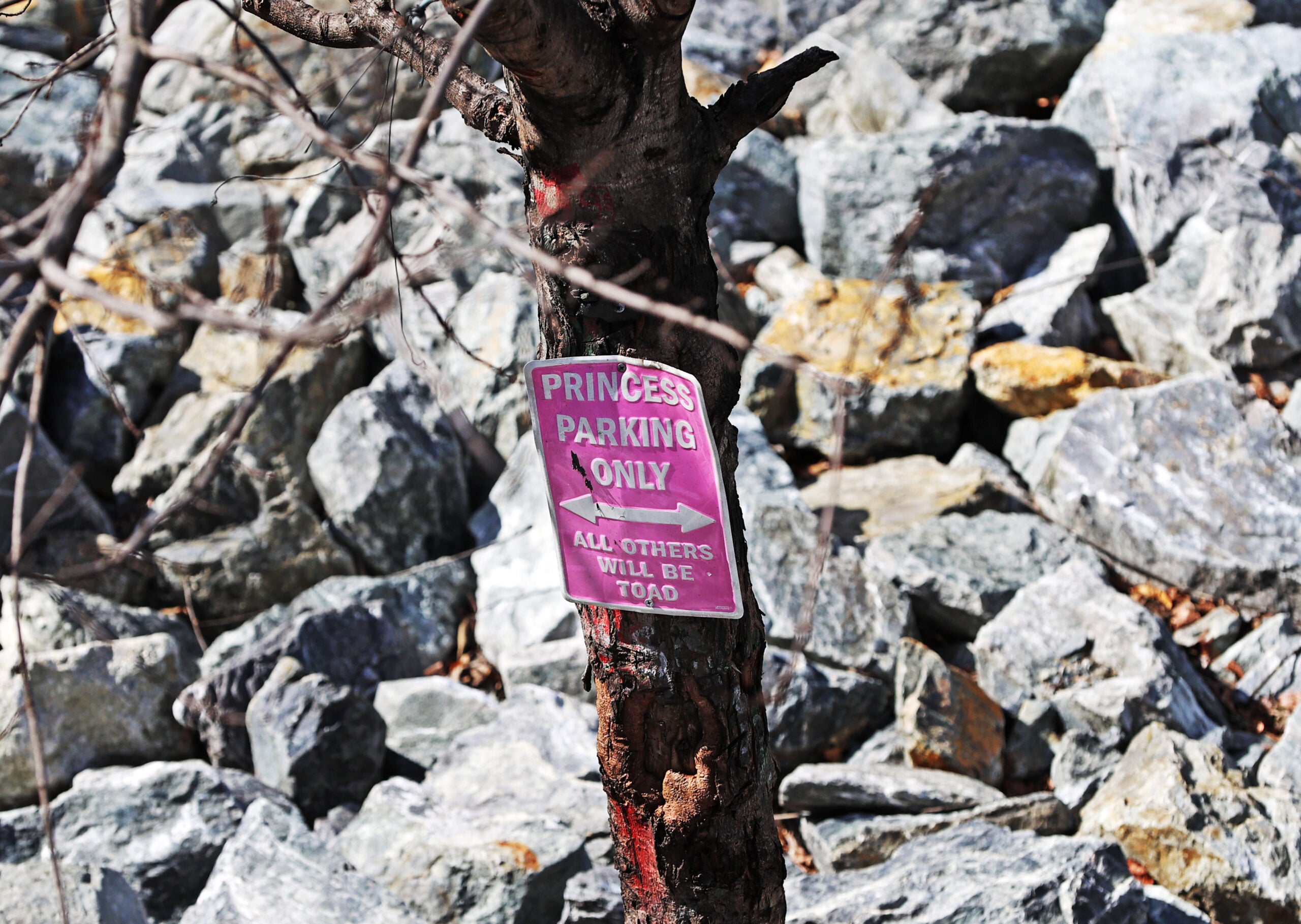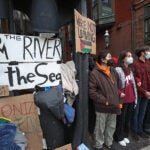Then: a homeless encampment near the BU Bridge. Now: Hundreds and hundreds of jagged rocks.
State officials say it’s to fight erosion, but advocates for homeless people aren’t so sure.

CAMBRIDGE — For years, collections of tents sprung up on a strip of land near the Boston University Bridge along the Charles River. Strewn with tarps, camping supplies, garbage, propane tanks, and needles, the small patch of riverbank was home to about a dozen people at any given moment.
In October, a fire spread rapidly in the campsite, igniting the gas tanks and sending up a thick cloud of black smoke that could be seen on either side of the river. Traffic was shut for hours. No one was hurt, but 10 people were displaced, and in the aftermath, fire officials said damage to the land was extensive.
Five months later, there are no more tents, no more people; instead the sloping embankment is covered with hundreds of pointy rocks and boulders that make it even more uncomfortable to sleep on the ground.
The state said the change is intended to help fight erosion and protect the bridge. But advocates for the homeless see the jagged additions to the terrain, which cover nearly every square foot of ground with sharp edges, as a not-so-subtle attempt to discourage people from sleeping there.
About 100 feet perpendicular to the river and bound by the bridge on one side and a barbed wire fence on the other, this shoulder land offers just one small glimpse into how the state, struggling to address the causes of homelessness, is left instead to treat its symptoms.
The Department of Conservation and Recreation, the agency that controls the riverfront, decided to install rocks after talking with Cambridge officials about the extent of damage from the fire and years of squatting, spokesperson Brenna Galvin said, noting the agency has also used similar rocks to fight erosion down the river at Cambridge’s North Point Park.
Cassie Hurd, executive director of Cambridge-based Material Aid and Advocacy Program, a nonprofit that supports unhoused people, suspects the move had more to do with discouraging the former occupants of the site than the state is willing to say. She considers the ragged terrain “hostile architecture,” the word for landscapes or furniture designed to be inconvenient or even painful for people trying to sleep.
“I in no way believe DCR’s primary goal in dumping large boulders alongside the bridge after sweeping a longstanding community encampment was to prevent erosion, though it is perhaps an additional purpose,” Hurd said in an email.
The collection of tents near the bridge had been there for at least a few years, and were well known to those who passed it by boat or on foot. News reports on trash accumulating at the site, and stolen bikes being tracked back to tents there, began to emerge around 2019.
At one point, Cambridge hired a cleanup crew to clear the area, and arranged a State Police detail to remove tents and other gear in 2022.
Not long after, the tents returned. Around the same time, Boston passed a citywide ban on camping and cracked down on the sprawling tent encampment in the area known as Mass. and Cass, pushing some unhoused people to look for more discreet places to live outdoors off of main streets.
Hostile architecture isn’t always quite as subtle, or open to interpretation. The state Department of Transportation courted controversy in 2019 when, as part of an effort to discourage homeless people from gathering under an overpass on Route 2 near the Minuteman Bikeway, it installed a row of long spikes, like the kind used to scare away birds. Facing backlash, it removed them days later.
When the MBTA added hand rails to benches in some stations, which it said were meant to make them more accessible for people with disabilities, critics accused the agency of installing them merely to stop people from sleeping on them. Some activists removed them illegally.
Criticism of the practice has gained prominence in other cities as well. In New York City, critics have noted the growing and increasingly creative practice at private developments of adding sharp, pointy edges to flat surfaces such as railings, ledges, or on top of water pipes that might otherwise provide a place to sit or lie down.
But while landscaping or decor choices that dissuade people from bedding down somewhere may succeed at reducing the population of homeless in a given area, it accomplishes little else, said Mark Martinez, housing attorney with the Massachusetts Law Reform Institute, which advocates for policies that help poor and homeless people.
“You’re not getting rid of homelessness, you’re not solving homelessness. You’re just putting people in different areas,” Martinez said. “And often, the more you push them out of particular areas, you’re putting them into more precarious and more dangerous situations.”
Some who wind up in encampments are reluctant to use shelters, where many people sleep inside in one area, because they don’t feel safe, Martinez said.
While they are no alternative to stable housing, and can be rife with hazards like propane tanks, the encampments provide safety in numbers, a consistent place to lie down, and at least some sense of community with others, he said.
As Massachusetts grapples with an overburdened shelter system, some encampments have recently popped up in new spots, including under an I-93 ramp in Somerville, which has become a focal point for local officials who fear for people’s safety living so close to passing cars.
Fixing the problem long term would mean addressing the housing crisis, which has seen the cost of apartments ratchet up year after year, putting them further out of reach for people trying to escape homelessness, advocates said.

“The only way to solve this problem is to have these people safely housed. You can’t just ban homelessness,” Martinez said. “I don’t think people sleeping under a bridge is an ideal situation for anybody. I don’t think fire happening near major infrastructure is ideal for anybody. But as long as we continue to just treat the symptoms of the housing crisis and just treat the symptoms of homelessness, we’re going to continue to have these problems.”
Whatever they were designed to do, the rocks beside the BU Bridge do appear to have kept people from gathering there.
On a recent cold and windy afternoon, there were no tents, mattresses, or trash that would suggest people had been sleeping in the area. Aside from the boulders and the handful of trees jutting up from them, the only other object visible on the suddenly jagged expanse was a small pink novelty sign attached to a tree that read “PRINCESS PARKING ONLY.”
Just across the river, a few other tents had popped up on the Boston side near Storrow Drive, along with tarps and other survival supplies. Anyone who had come to this part of the riverbank looking for a place to sleep outdoors, only to find the rocks strewn on the ground, would not need to go far to find a clear space somewhere else.









Conversation
This discussion has ended. Please join elsewhere on Boston.com